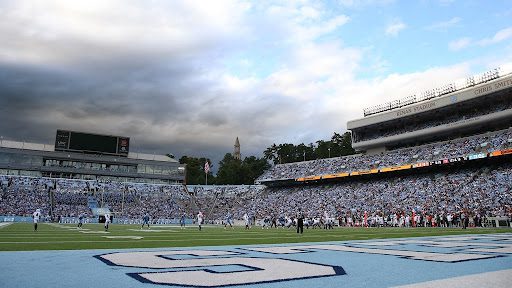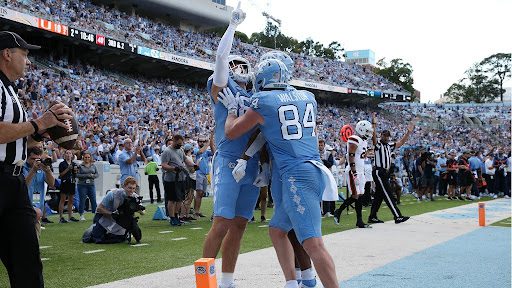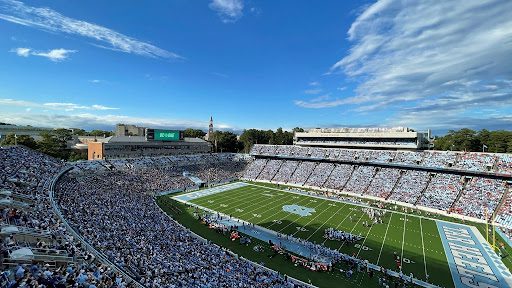Zero is the goal for the University of North Carolina football program. Actually, three zeros. Confused? It’s not their on-the-field performance we are talking about – it’s their stadium. Kenan Memorial Stadium is part of the university’s The Three Zero Environmental Initiative.
In 2016, UNC announced a university-wide program with a mission to reach three zeros – Net Zero Water, Zero Waste To Landfills, and Net Zero Greenhouse Gases – by 2050. The Three Zero principles were apparent when the Athletic Department decided to replace Kenan Stadium’s aluminum bleachers with stadium chairs in 2018. “We wanted to make sure the bleachers were removed in the most environmentally and fiscally responsible way possible,” shared Bubba Cunningham, UNC’s Director of Athletics. So, instead of simply sending approximately 200,000 pounds of aluminum to a landfill, they sold it to a company that specializes in recycling metal. The sale, moreover, covered the costs of removing the bleachers, resulting in a “net-zero cost, green project.”

UNC’s Athletic Department and Kenan Stadium, however, aren’t Johnny-Come-Lately to environmentally responsible actions. Back in 2003, the Athletic Department joined with several other University offices and organizations to launch recycling campaigns at athletic events. An early program focused on cardboard recycling involving the stadium’s housekeeping, event, and foodservice departments. In 2004, a plastic bottle and cup recycling program was initiated and began picking up speed once volunteers were utilized to distribute color-coded bags to help fans properly recycle trash, glass, and plastics. The Rameses Recycles program has continued to evolve over the years. To make the process easier for fans, trash cans and recycling bins were placed next to each other. And additional bins – distinctively shaped like Coke bottles – were added following a deal with the soft drink company in 2013. By the 2018 season, more than 2 tons of materials, on average, were recycled at each home game.
Rameses Recycle had to alter its game-plan in 2019 when changes in processing requirements prevented plastic bags from being used for disposing of recyclables. Now, Rameses requests fans “keep it loose” – meaning no plastic bags, no paper or plastic cups, and no food brought into the stadium – as well as asking fans to carry out all items (particularly recyclables) that they bring into the stadium. Rameses’ years of sustainability efforts have made UNC’s fanbase savvy about recycling.
Kenan Stadium is stocked with recycling bins for bottles and cans, with dumpsters in the parking lots for tailgaters. Additionally, Water Monsters water stations are located around the stadium, allowing people to fill up their bottles for free – thereby reducing plastic bottles use and sales. Kenan also provides paper items like toilet paper and napkins from recycled content products and post-consumer content (such as cardboard, newspaper, and plastics). Purchasing supplies made from recycled materials cuts down on the amount of paper waste dumped at landfills.
In 2010, North Carolina began participating in the EPA-initiated Game Day Challenge, a friendly competition between two schools to see which could reduce and recycle more waste from a single home football game. UNC’s achievement in the 2011 Game Day Challenge earned them a Carolina Recycling Association Award.
More innovative thinking came into play in 2015 when UNC Athletics teamed up with Unifi (a company that creates eco-friendly fabric from recycled plastic bottles). For that season’s #TurnItGreen football game at Kenan Stadium, Unifi supplied fans with UNC t-shirts, rally towels, and other items – all of them made from over 20,000 plastic bottles.
UNC jump-started its water conservation efforts in 2003 following North Carolina’s worst drought. The university collaborated with the local Orange Water and Sewer Authority to create a system that treats reclaimed water so it can be used in flush toilets and to water fields in Kenan Stadium and other University facilities. It is estimated this system replaces up to 10 million gallons per year of the more expensive potable water.

Underneath UNC’s athletic fields and parking structures are large cisterns that capture rainwater and irrigation runoff. These cisterns have a combined capacity of nearly 700,000 gallons. Utilizing this recycled water also allows the university to purchase less water from OWASA water. Further water-saving measures include switching out traditional fixtures for low-flow ones. The new showerheads in the locker room cut water use by half while the toilets’ dual-flush valves decrease water consumption up to 30% per flush. Kenan Stadium became even less water-dependent in 2019 when new synthetic turf replaced the grass one. Artificial turf provides additional eco-advantages because it doesn’t have to be watered, fertilized, and resodded as grass does.
In 2009, the stadium’s energy usage decreased after LED lights were installed on the field and in the stands. LED lights use far less energy and emit less carbon dioxide than incandescent bulbs do. Also, the stadium is wired into UNC’s Energy Management Control System. This high-tech dashboard regulates heating, cooling, and energy usage, which conserves energy and other resources. “From LED lighting to low-flow fixtures,” states Richie Grimsley, Assistant Director for Facility Planning and Management. “We’re always looking for ways we can support sustainable initiatives.”
Like a football team charging down the field, Kenan Stadium and UNC Athletics are continually making progress in sustainability as they work towards crossing the goal-line and scoring Three Zeros.





